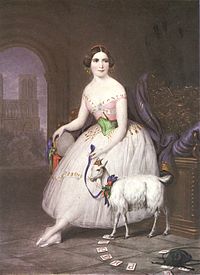Annotation:Esmeralda Polka (La): Difference between revisions
mNo edit summary |
No edit summary |
||
| Line 1: | Line 1: | ||
---------- | |||
---- | {{TuneAnnotation | ||
|f_tune_annotation_title= https://tunearch.org/wiki/Annotation:Esmeralda_Polka_(La) > | |||
'''ESMERALDA POLKA, LA.''' Polka (2/4 time). C Major. Standard tuning (fiddle). ABACA. "La Esmeralda" takes its name from a ballet of the same name in 3 acts, 5 scenes, inspired by Victor Hugo's '''Notre Dame de Paris'''. It was originally choreographed by Jules Perrot, with music by Cesare Pugni (see also note for "[[Annotation:Opera Polka]]"). | |f_annotation='''ESMERALDA POLKA, LA.''' AKA and see "[[Royal Polka Quadrille - Figure 3]]." Polka (2/4 time). C Major. Standard tuning (fiddle). ABACA. "La Esmeralda" takes its name from a ballet of the same name in 3 acts, 5 scenes, inspired by Victor Hugo's '''Notre Dame de Paris'''. It was originally choreographed by Jules Perrot, with music by Cesare Pugni (see also note for "[[Annotation:Opera Polka]]"). | ||
[[File:esmeralda.JPG|200px|thumb|left|Fanny Cerrito in the title role of the Pugni/Perrot La Esmeralda, London, circa 1844.]] | [[File:esmeralda.JPG|200px|thumb|left|Fanny Cerrito in the title role of the Pugni/Perrot La Esmeralda, London, circa 1844.]] | ||
<br> | <br> | ||
The Esmeralda, sometimes called the Three-Slide Polka, was a ballroom dance popular in America in the second half of the 19th century. It consisted in a combination of steps from the polka and the galop. The music was usually a polka in 2/4 time; occasionally a 6/8 time tune was used. | The Esmeralda, sometimes called the Three-Slide Polka, was a ballroom dance popular in America in the second half of the 19th century. It consisted in a combination of steps from the polka and the galop. The music was usually a polka in 2/4 time; occasionally a 6/8 time tune was used. | ||
|f_source_for_notated_version= | |||
|f_printed_sources=Manson ('''Hamilton's Universal Tune Book, vol. 2'''), 1846; p. 145. | |||
|f_recorded_sources= | |||
|f_see_also_listing= | |||
}} | |||
Revision as of 17:48, 21 December 2022
X:1 T:Esmeralda Polka, La M:2/4 L:1/8 R:Polka B:Manson - Hamilton's Universal Tune Book vol. 2 (1846, p. 145) Z:AK/Fiddler's Companion K:C G|ee/f/ gc|e{e}d/^c/ d/e/f/g/|ad/e/ fB|c/c'/b/a/ g/a/g/f/| ee/f/ gc|e{e}d/^c/ d/e/f/g/|ad/e/ fB|c/c'/g/e/ c!Fin!|| G/c/|e e2e|ee{g}fe|eded|dcdc| e e2e|ee {g}fe|eded|ce/g/ c'!D.C.!|| d/e/|d b2 b/c'/|ba a/b/a|c a2 a/b/|ag g/a/g/| d b2 b/c'/|ba a/b/a|daba|agg!D.C.!||
ESMERALDA POLKA, LA. AKA and see "Royal Polka Quadrille - Figure 3." Polka (2/4 time). C Major. Standard tuning (fiddle). ABACA. "La Esmeralda" takes its name from a ballet of the same name in 3 acts, 5 scenes, inspired by Victor Hugo's Notre Dame de Paris. It was originally choreographed by Jules Perrot, with music by Cesare Pugni (see also note for "Annotation:Opera Polka").

The Esmeralda, sometimes called the Three-Slide Polka, was a ballroom dance popular in America in the second half of the 19th century. It consisted in a combination of steps from the polka and the galop. The music was usually a polka in 2/4 time; occasionally a 6/8 time tune was used.

